Each parent worries about the health of his child from the first days of life. Many ENT diseases are directly related to improperly created conditions in the room where the child is. For the normal functioning of the body, especially in a newborn, temperature and humidity in the children's room are important. What should be the best indicators and how to maintain and adjust them, let's try to figure it out.
The body of the newborn is still imperfect, the regulation of body temperature occurs with some difficulties, which occurs due to intensive metabolism. In turn, a large amount of heat is generated, which the child needs to get rid of, there are two options - through the lungs and pores on the skin.
When the baby inhales air, then when it enters the respiratory system, it heats up. If air with a temperature above 23 ° C enters the lungs, heat loss at the outlet is reduced and the body is freed from heat excess through sweating. A newborn loses moisture and salt, and an insufficient amount of fluid in the body provokes a violation of many vital systems.
The humidity level in the children's room is extremely important, dryness is very harmful, especially for the baby’s respiratory system. The expiratory air temperature is normally 36.6 ° C, and the amount of water vapor in it is 100%, the body spends liquid to eliminate dryness, and this is an additional flow of water.
Overheating is no less dangerous for a child than hypothermia, especially at an early age.
Moisture and heat standards
![]()
The correct temperature and sufficient humidity in the children's room are the main conditions for a comfortable stay in the child. Dryness and excessive heat in the room can cause many diseases. Loss of fluid leads to a violation of the water-salt balance, and sometimes even to dehydration.
Increased sweating in an overheated and unventilated room provokes skin problems in a child, namely redness, dermatitis, diaper rash, rash, urticaria. Each mother has at least once encountered one of these troubles and knows how hard it is to get rid of them. It would be worth considering if there was an air overheating in the room?
In addition, the child may be disturbed by stomach pains, problems with stools, because a lack of fluid leads to problems for the newborn in digestion, gastric juice liquefies poorly and food is not digested completely. Lack of water in the body threatens the appearance of thrush - white spots in the mouth. In this case, saliva becomes too thick and cannot fully perform the functions of moisturizing the mucosa. There may be problems with the eyes of the child, they can fester, as little fluid enters the organ of vision.
From the ENT organs, insufficient air humidity in the apartment and an excess of temperature threaten the appearance of:
- Dry crusts in the nose.
- Difficulty breathing.
- Dry rhinitis.
- Cough.
- Decreased self-cleaning ability of the bronchi.
- Edema of the respiratory tract.
- Increased susceptibility to SARS.
- Nosebleeds.
- General deterioration of health.
- Exacerbations of chronic diseases.
All this is often accompanied by lethargy, moods, anxiety, increased heart rate. It is worth noting that the presence of dampness in the room will bring a lot of troubles, such as: headaches, pneumonia, bronchial asthma, respiratory system diseases, nosebleeds and indigestion.
Optimum humidity in the room where the child is staying for a long time reduces the risk of these problems, if you do not want to encounter them, observe the temperature regime and control the air humidity.
Optimal temperature and humidity in the room
How many degrees should a thermometer show, what humidity should be adhered to, taking into account the opinion of experts? When it is born, the child spends the first days of his life in the hospital, the recommended 22 ° C is usually observed there. Doctors advise sticking to the mark of 18-21 ° C - this is the norm for babies. Such parameters will be acceptable for healthy children, in case of prematurity the room should be warmer by 3-5 ° C. Dr. Komarovsky believes that the air temperature in a room of a healthy child should not exceed 18–19 ° С.
It should be borne in mind that babies feel different at the same temperature. Room conditions are appropriate if your child has:
- Good calm sleep.
- There is no excessive sweating and redness on the skin.
- The limbs are warm.
- Normal heart rate and breathing.
Especially often, dryness in a room can be detected during the heating season, because parents are diligently trying to heat an apartment or house. Many parents wonder, what is the optimum humidity for the child in the apartment? Typically, the humidity in such rooms does not exceed 30%, and this is very small. The optimal indicator is considered to be 50–70%, for children it is still better to stick to 70%.
To track temperature and humidity, install a thermometer and a hydrometer near the crib.
Temperature and humidity control
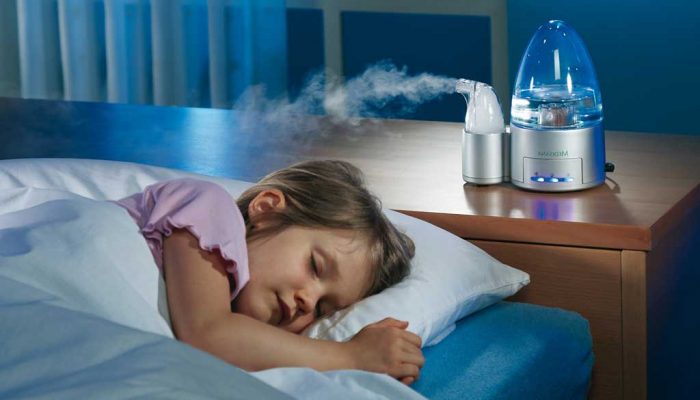
In the child’s room, the temperature regime must be followed first. If the room is too warm and the readings on the thermometer are above the norm, you need:
- To do frequent airing (open all windows in the room, but only in the absence of the baby).
- Turn on air conditioning only in neighboring rooms.
- Cover hot batteries with a blanket.
- It is advisable not to hang the canopy over the bed (this complicates the circulation of air).
- Do not wrap the child strongly, do not wear a lot of clothes.
- Give drink plenty of water.
- Bathe in the bath (you can 2 times a day).
If the room is cool and the temperature is below 18 ° C, you should use a heater, but be sure to often ventilate the room. It is important to bathe the child at the same temperature that he is used to, in order to avoid freezing.
The humidity must be within the norm, but if its indicators are lower, you need to buy an air humidifier, place several open containers with water in the room, put an aquarium or cover the batteries with a wet, thin cloth. If the house is damp, do the cleaning; if it is ineffective, you will have to make repairs and warm the room.
After the silence and tranquility of the mother’s womb, the baby enters our world without effective thermoregulation mechanisms, so caring parents are responsible for maintaining a comfortable temperature. In order not to harm the child in the very first days of life, it is important to maintain the right climate, avoiding hypothermia and overheating.
Signs of overheating it is easy to recognize, because they give the baby great discomfort.
The skin of the baby becomes red, covered with sweat, and diaper rash appears in places of accumulation of sweat secretions. White spots of thrush can appear in the mouth, and dry crusts that make breathing difficult in the nose form. Due to dehydration, the baby may have difficulty with digestion.
If you find these symptoms, try lowering the air temperature in the room, rid the baby of extra clothes, and give him some water between meals. .
If the baby is cold , you will notice that his nose, legs and arms are not just cool, but “ice”, he presses the arms of the legs to himself, keeping it warm. In this case, you need to use socks and warmer clothes or a blanket. Signs of hypothermia can be reduced appetite and lethargy, slowing down weight gain. With hypothermia, the likelihood of colds also increases. But still remember that it is much easier to overheat a child than to supercool.
Optimal temperature in the baby’s room
Pediatricians recommend maintaining the temperature in the baby's room at 18 to 22 degrees. Under such conditions, a baby usually needs a light body or vest with a medium density plaid for a comfortable sleep. For children born prematurely, it is worthwhile to slightly increase the temperature, to 24-26 degrees.
To easily control the climate in the children's room, hang a thermometer on the wall near the crib. One glance at his testimony will be enough for you to determine the cause of the baby's concern.
How to adjust the room temperature?
When you determine the appropriate temperature for your baby, you just have to maintain it at a constant level, which is far from simple in an ordinary apartment.
To reduce the air temperature in the summer heat, you can use the air conditioner. It is important that the stream of cool air is not directed at the bed, and it is better to cool the room when the baby is outside. You can get by with normal ventilation, which is recommended to be carried out several times a day, while the baby is on a walk or in the next room.
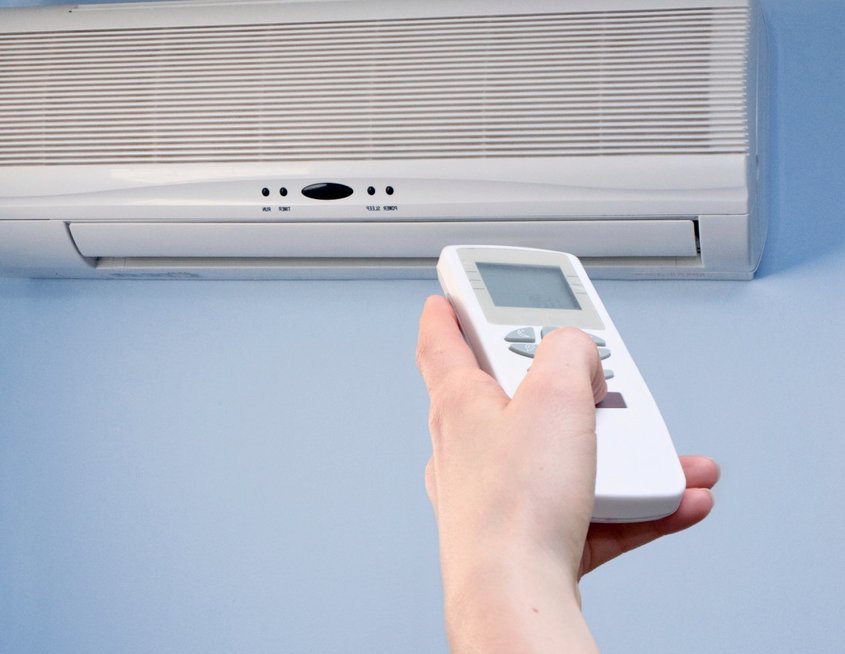
Maintaining a comfortable baby temperature in winter can be more difficult than in summer. To heat the room, an electric heater without an open spiral is suitable, but an excessively heated room can be cooled by ventilation. You can reduce the heat from a battery that is too hot by covering it with a thick blanket or blanket.
When heating appliances or central heating it is important to pay attention to the relative humidity, which in the room of the baby should not fall below 50%. Instead of special humidifiers, you can use open containers of water, wet towels or fountains.
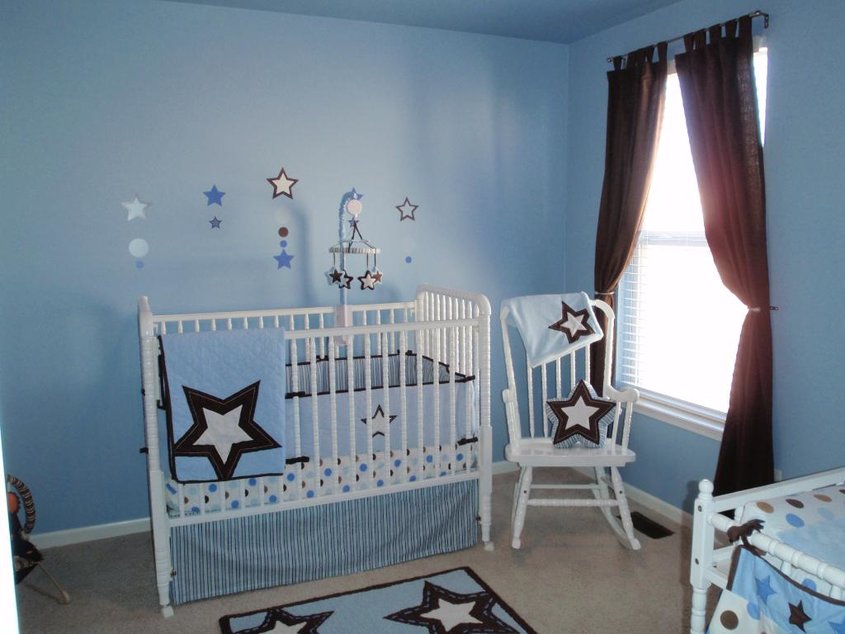
An individual approach to each baby
Now you have an idea of \u200b\u200bthe general recommendations of pediatricians regarding the optimal temperature for the baby, but do not forget about the importance of an individual approach. Depending on the metabolism, month of birth and the general state of health of the baby, he may need a higher or lower temperature. Do not be afraid to deviate from general recommendations and use common sense to provide your baby with ideal conditions.
For a healthy child, the norm of the temperature regime in the room is 18-21 degrees.
Birth is a transition from a comfortable environment of amniotic fluid and the mother’s body into the airspace, in which three times the force of attraction acts on a person. Optimal living conditions includetemperature in the room of the newborn, normal it is clearly indicated by obstetricians and pediatricians.
Principles of organizing living space for a newborn
The body temperature of the newborn is greater than in adults. The child loses heat mainly in the process of breathing. A normal pulse is also normal (110-140 beats per minute). The number of heart tremors increases after any physical activity, including feeding, bathing, changing clothes.
Humidity should be at least 50% (it is often advised to increase it to 70%). In such a microclimate crumbs easily breathe, and crusts do not appear in the nose. Infants quickly lose moisture, which is released through the pores on the skin and evaporates. Regular hydration of the baby’s room helps maintain moisture balance, prevents peeling and microcracks on the baby’s skin.
The crumbs that were born during the heating period, especially acutely feel how dry the air is, especially if fan heaters and infrared heaters are used to heat the room. In addition to basic hygiene items, the following attributes should be in the room of the newborn:
humidifier;
hygrometer - a device for measuring the level of humidity.
Air changes (ventilation) should be carried out regularly. When the baby grows up, you can safely reduce the usual temperature by 2-3 degrees. Fresh air in combination with swimming contributes to a sound, restful sleep. When the window opens, the baby is taken out of the room so that drafts and temperature drops do not lead to a cold. It must be remembered that the air inhaled by a child acquires body temperature when it makes its way to the lungs. If the room has become a little colder than usual, it is not as critical as constant overheating, sweating and subsequent sharp cooling of the skin.
Gentle but thorough cleansing of the baby's skin is a requirement of hygiene, a guarantee of health and comfort. To become a pleasant procedure, the water should not cool below 37 ° C. A water thermometer will help to monitor the indicator. It is with warm baths that the hardening process begins, if after the main stage of washing, rinse the baby with 36-degree water, and after that - pat the skin with a soft towel.
During any procedure, the baby is in contact with the environment. Swaddling is a kind of air bath, airing is a necessary “way out of the comfort zone” for babies, which, due to their low weight, are not recommended to be taken out for up to a month. This prescription in the past was almost an axiom. Now parents have the right to decide when to start walking, but they can’t do without consulting a doctor. Thus, the weight of the baby is the main factor determining the rate of temperature in the room where he lives.
For convenience, you can study the correspondence system "Baby weight and air temperature norm":
2-2.5 kg - 25-26 ° C;
2.5-3 kg - 23-24 ° C;
3 kg and above - 18-22 ° C (permissible 18-19 ° C).
With a weight of up to 2.5 kg, a constant temperature in the room is a condition for proper development and even survival. In special situations, the baby is placed in an "incubator", which eliminates the possibility of overheating or hypothermia. With a weight of 4 kg, the optimal indicator of a room thermometer is 20-22 ° C. In the future, you must try to maintain such conditions.
In addition, the regulatory processes in the child’s body already make it similar to adults, and to a greater extent this relates to the ability to maintain the desired body temperature, regardless of how warm or cold it is. Of course, this does not mean that the baby can be in the heat under the scorching sun or lie in a stroller on the balcony on a frosty day. Everything has its own time, place and control!
What humidity should be in a nursery and its optimum level? What goals are being pursued, and what result should be obtained, or will be, according to Chernomyrdin, “they wanted the best, but it turned out, as always.” An indisputable fact remains the assertion that in infants the mechanisms regulating body temperature and air humidity in the children's room have not yet been launched.
This will be one of the factors preventing the child’s disease or help to shorten the period of the disease. Due to hypothermia, a baby may experience a painful condition due to imperfect mechanisms of regulation of the temperature regime of the body. The video in this article presents how the wrong conclusions are drawn from this correct position.
So:
- Trying to protect the baby from hypothermia, parents believe that the acquisition of an electric heater is one of the indispensable steps in preparing a meeting for a newborn.
- The instruction prescribes to keep the air temperature in the chambers of newborns not lower than 22 ° C (in practice it is higher), therefore parents make every attempt to keep the temperature in the children's room no lower than in the hospital, and even higher if possible.
- In most cases, a typical feeling of lack of air occurs even after a short stay in the room for a newborn, especially with a heater.
- Panicky afraid of cold air, parents do not attach importance to the overheating of the baby, if only it would not be cold.
- The regulation of temperature conditions in newborns is carried out in two ways - ambient temperature and clothing.
- For the first time, parents can solve these problems by hours of returning home from the hospital and do not forget to buy a humidifier in the children's room, a lot of which has been written about.
It is better to subcool, overheat or moisturize.
Often, a confusion of the concepts “the child is cold” and “the temperature of the air that the baby inhales” leads to a curvature of the basic rule of a person’s life. It is better to supercool than to overheat, so the temperature in the room of children and adults should be 18ºС-19ºС. Yes, yes, indignant voices are heard, and yet overheating is more dangerous than hypothermia if the humidifier for the children's room is still waiting for the owners in the store.
Children are born everywhere in the heat and in the cold, in villages and cities, in sanitary and unsanitary conditions, but there are several main ways to prevent it from overheating:
- Minimum amount of clothing, preferably made from natural materials.
- Adequate intake of water in the child's body.
Attention: Milk for feeding a child is food, and sufficient liquid for the normal functioning of the baby’s body is water and must be supplied in sufficient quantities.
- Daily bathing of newborn children in the bath.
- An equally significant factor is the humidity level in the children's roomdue to the peculiarity of thermoregulation of children. The less moisture in the air and on land the inhaled mixture, the more fluid the body needs to moisturize, and the additional loss of water always occurs with the release of healthy salts.
If you look at the statistics, the majority of the population lives in climatic conditions, where heating systems operate from autumn to spring. A fundamental feature of the heating season is the operation of systems that can dry the air in the rooms and in the children's room in particular.
How to solve the problem, what should be the humidity in the children's room and how to keep it at the proper level? The optimal relative humidity is considered to be 50-70%, and air heating reduces humidity by almost 2 times lower than recommended, although there is more than one way out.
- Wet cleaning of the children's room.
- Regular airing of the baby's room.
- Water tanks and wet towels on batteries.
- Spraying flower leaves from a spray bottle with clean water.
- Installation of decorative fountains.
- Breeding fish in the aquarium.
The desired goal, modern technology can be obtained in less time-consuming ways.
Science to help parents
How to choose a humidifier for a children's room and are there any of the best among them?
Before proceeding with the selection, it is necessary to familiarize yourself with their varieties:
- Steam speak for themselves and work on the principle of a boiling kettle. The built-in heater evaporates the water, and the steam jet is supplied by the fan into the air, moistening it. A legitimate question arises, what to do when the water runs out, will not its end lead to overheating and then to a fire? In this case, automatic shutdown is provided. Pure water is poured inside any, it is possible with aromatic oils.
Attention: These humidifiers have undesirable disadvantages for consumers - high energy consumption, hot steam emission, which can cause a burn if touched.
- The operation of the steam appliance is quite noisy and if the child sleeps in perfect silence from the first days, his sleep can disrupt the second hand on the clock, not to mention the unit. Such a humidifier into the nursery of a small child is not recommended.
- A modern invention, relatively recently included in the everyday life of houses is an ultrasonic humidifier. Its modernity does not guarantee against negative aspects in operation and is present along with positive aspects.
- The advantages of these devices include effective and quick hydration.
- Silent work.
- Small, compact sizes.
- The disadvantages are the possibility of waterlogging and the appearance of dampness in the room.
- Ultrasonic humidifiers for a children's room are filled with special distilled water.
- The developers solved the problem with waterlogging by integrating a hygrometer. When humidifying the air to normal, the device turns off. An alternative to distilled water has not yet been found, and attempts to fill the humidifier with ordinary water leads to the evaporation of salts from the water and the formation of plaque on furniture.
- What should be the humidity in the children's room, and whether a cold humidifier that works on the principle of evaporation is suitable. Water falling on the plates is evaporated by a fan.
- Their use guarantees against waterlogging.
- Silent work.
- Low power consumption.
- Avoiding water heating, it became possible to add silver particles to the filter fibers. Silver has the ability to destroy many different types of harmful bacteria.
- A fly in the ointment in this barrel of honey will be a high price and size superior to other similar units.
- The best humidifiers for the children's room are chosen by parents, based on the personality of their child.
Attention: Children with underdeveloped lungs under 4 years old are not recommended to breathe air with fine dust, which is emitted by an ultrasonic humidifier.
- Many diseases are very young, and allergic reactions are observed in babies. When a child has intolerance to certain things, it is better to get a moisturizer as in the photo, controlling and purifying the air.
- Their difference is the ability to pass air through a special barrier, that is, a filter. On the filter settles wool, pollen of plants, ordinary dust. Air is cleared of tobacco smoke, carbon monoxide and unpleasant odors.
- To fully appreciate the help of science, buy an ionization humidifier for your child’s room and spare no money.
- Scientists in many countries are constantly engaged in the problems of the human body and the processes taking place in it.
- It has been established that oxygen, which is vital for it, is absorbed from air enriched with negatively charged particles (aero ions). I immediately remember the air after a thunderstorm and Tyutchev’s poem “I love a thunderstorm in early May ...” and nothing can prevent parents from creating a similar atmosphere in the children's room, thereby improving his state of health.
- For children with asthma and suffocating in dry air, experts strongly recommend purchasing a modern moisturizer with corrector with your own hands.
- Have you noticed that some of the proposed models have ultraviolet lamps?
- For human, weakened immunity, clean air without viruses and bacteria, saturated with active oxygen, is simply a panacea for infectious infections, so the devices should be installed not only in child care facilities, but also in offices, homes.
You can choose the best humidifier for a child’s room in any store, relying on just a couple of basic criteria - efficiency and safety.
You can hear many compelling arguments from opponents of the new and lovers of recalling the old days, but why refuse technical progress if it is of great benefit? You cannot buy health for money, but they will help to preserve it from an early age, if you take care on time and apply all available methods for this.
The quality of a child’s sleep is affected not only by the regimen appropriate to age and needs, associations to falling asleep and developmental jumps. The conditions in which the child sleeps also matter.
In this article we will talk about the importance of such external factors important for sleep as temperature, humidity, light and noise. And how to create conditions favorable for a newborn to sleep.
How to create comfortable sleeping conditions for a child?
Temperature
It's believed that optimum temperature in the bedroom - 18–22 ° С. If the baby is hot, this will interfere with his sleep. No need to wrap up the child, put on him an extra layer of clothing "just in case". Cool hands, legs or a nose during a child’s sleep is not an indication that the child is cold. Hiccups are also not a sign of freezing. To assess whether the baby is cold, touch him from behind at the very bottom of the neck. If the skin is warm there, then everything is in order.
However, the cause of the poor sleep of children may be that the child is freezing. Many young children do not like to be covered (in addition, for children under one year old, blankets are not recommended due to the risk of SIDS). And even if the child agrees to a blanket, up to 2-3 years he is unlikely to be able to take refuge on his own. So, when laying the baby, you will cover, and if the child throws off the blanket during sleep, he will need your help again. The solution in this situation is to replace the blanket with a warm slip, pajamas with socks or a sleeping bag.
Humidity
Recommended humidity in the room is 40-60%. If the air is not humid enough, the mucous membranes dry out in the child (and in the adult), microcracks form in them, through which microbes can easily penetrate. In addition, due to too dry air, the baby may be thirsty at night - another reason for awakening. Therefore, a sufficient level of humidity in the room is an important condition for a quiet baby's sleep.
There are concepts of absolute and relative humidity air. Absolute humidity is the amount of moisture that is contained in a cubic meter of air. The higher the temperature, the more moisture the air may contain. Relative humidity is the ratio of the real amount of water vapor in a cubic meter of air to the maximum possible at a given temperature.
When heated, the relative humidity decreases. That is, if you ventilate the room in winter, the air humidity inside will change very slightly, even if the air humidity is 100% outside: the cold air from the street in the apartment heats up and its relative humidity drops.
Favorable conditions for sleeping a child will help to create a humidifier. There are various types of humidifiers. Each has its pros and cons.
Steam humidifiers work on the principle of hot evaporation, heating water to a boiling point. Ultrasonic humidifiers using ultrasonic vibrations turn water into tiny droplets. The operation of cold-type humidifiers actually represents the usual process of water evaporation. Water is poured into the tank, which enters the evaporation element (plastic discs). The built-in fan draws in air and drives it through the plastic discs. The air washer uses a modified natural vaporization scheme.
pros | Minuses |
STEAM HUMIDIFIER |
|
Easy operation Tap water can be used. No consumables Can be used for inhalation | High power consumption Increases room temperature Hazardous to children due to hot steam |
ULTRASONIC HUMIDIFIER |
|
It can maintain the set humidity level in the room, turn on and off automatically Low noise | Mandatory use of water purifying filters or distilled water |
COLD TYPE |
|
Humidity control Safe for children Low power consumption Easy operation | It is advisable to use purified or distilled water. Has restrictions on the maximum level of relative humidity (about 60%) Does not allow precise humidity control |
WASHING AIR |
|
Can work on tap water Cleans the air from dust Low power consumption Humidity control possible | Price |
Shine
From 3-4 months in the body of the child begins to develop "sleep hormone" melatonin. The hormone level in children changes during the day: it increases in the evening, reaches a maximum around midnight and decreases in the early morning hours. The production of melatonin depends on the lighting - it stops in bright light. Therefore, in the evening, shortly before putting the children to sleep, we recommend dimming the lighting in the apartment.
It is advisable for the child to sleep at night in the dark. But if the baby is worried about scary dreams (usually this problem appears in children after 2 years), it is permissible to use a weak night lamp - it is better with a yellow or orange light.
Do not miss the new article about a baby’s dream |
During the daytime sleep of the newborn, it is not necessary to create complete darkness in the room. Moreover, in the first months of life, daytime dreams in a too darkened room can lead to the fact that the child will mix up day and night. In the afternoon, it is enough to dim the light before going to bed, for example, to close the curtains from the bright sun - this reduces the amount of irritants, and for the child it becomes an additional signal - “soon to sleep”.
Newborn children hear from the first days of life, but usually only respond to loud or sharp sounds. A newborn can sleep under a working TV or a quiet conversation. The older the child becomes, the more sounds he distinguishes in that “cacophony” into which all surrounding noises merged for him, and the more sounds can disturb his sleep.
Often there are tips not to accustom the baby to silence during sleep. But in this matter a lot depends on the temperament of the child, his sensitivity and excitability. If even quiet sounds can interfere with a child’s sleep, it’s better to arrange silence for him. A white noise generator may be useful

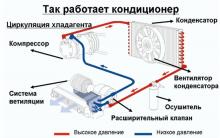
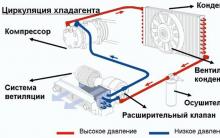
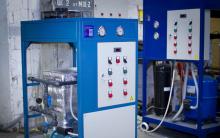
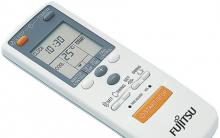
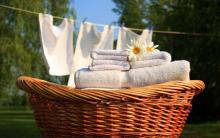
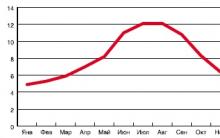




The best material for car trim
Principles of hardening the body
Do-it-yourself compressor - with minimal scrap costs
Which is better: do-it-yourself or factory-made compressor for painting a car
Causes of fuel pump malfunctions